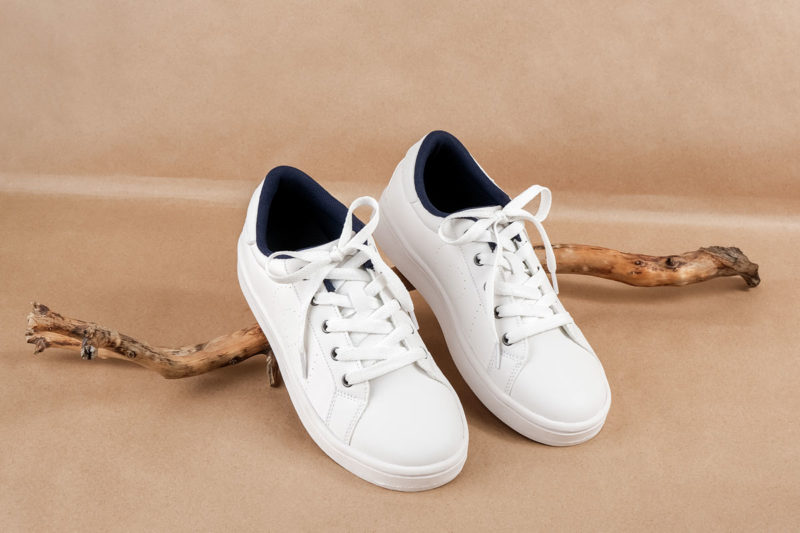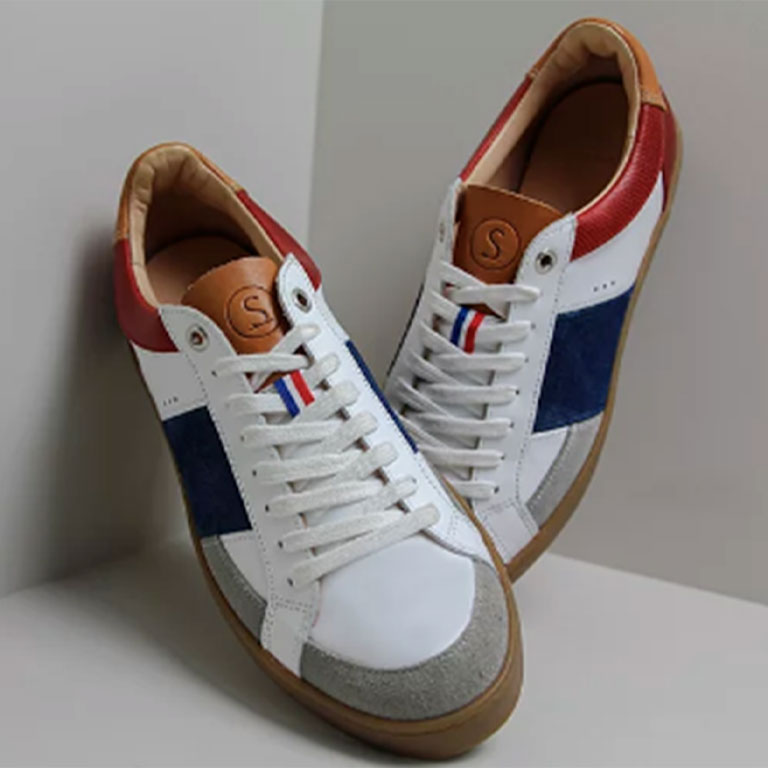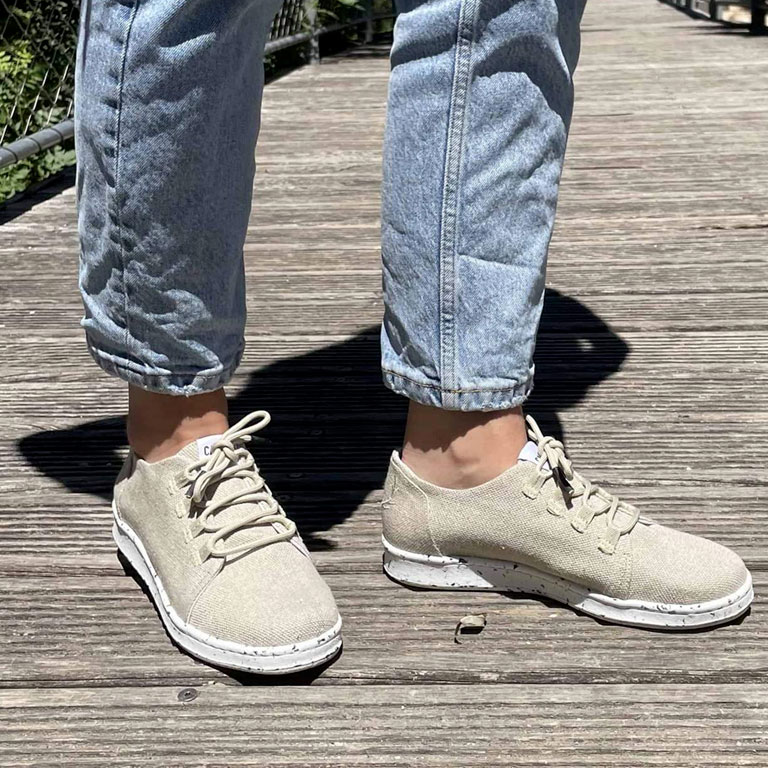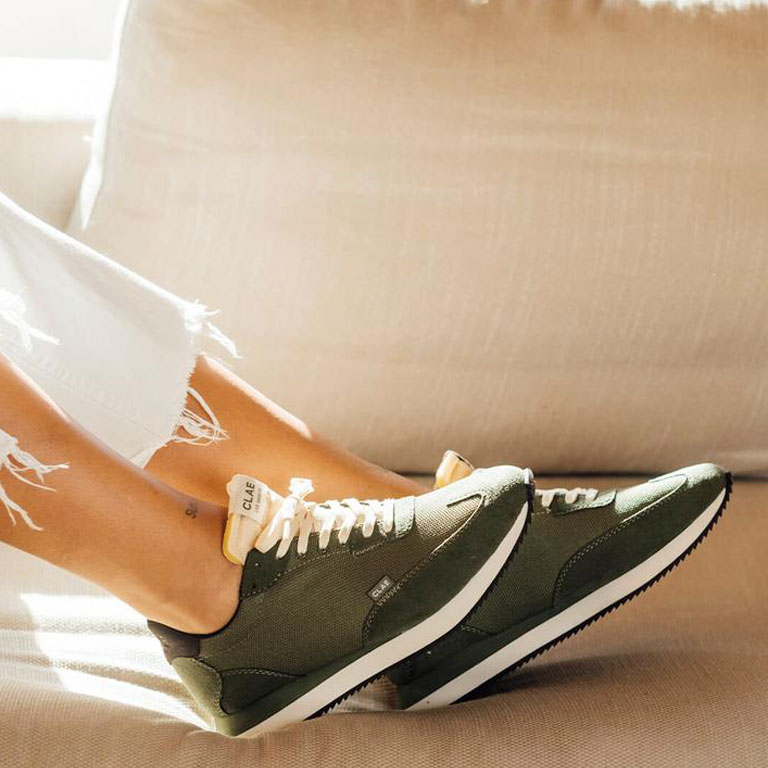We all have a pair of trainers, or even several! Only, this staple item in our shoe tidies – sometimes a cult item – is often far from virtuous. Raw materials, manufacturing conditions and its end-of-life phase are all problems that need resolving for our trainers to be clean.
At least here in France, more than one in two pairs of shoes purchased (72 million $) is a pair of trainers (or to be exact, sneakers, in American English) – athleisure shoes that are no longer only worn for sports. Their sales have been steadily increasing (5% per year) worldwide since the 1980s. That’s when this fashion trend took off, with the launch of the Nike Air Jordan One, and the signing of the historic partnership between basketball star Michael Jordan and Nike. Worldwide, sales reached 82 billion dollars in 2019, for some billion pairs produced. It is forecast that the global trainer market will reach annual growth of 7% between 2020 and 2024.
The problem: the vast majority of these shoes is still produced using polluting materials, in countries where workers are generally underpaid and where working conditions are often deplorable. Nonetheless, some progress has been made. Let’s shed some light on these cult shoes on our feet.
A societal phenomenon
The trainer is no longer only a sports shoe, and this has been the case for a long time now. Symbolic of streetwear, it’s the standard footwear of those aged under 20, who no longer wear anything else. And while they may be happy to buy jeans at Zara or H&M, some will in no way forego trainers emblazoned with that tick, those three stripes or that big cat motif. Each new shoe model is launched with marketing plans on a par with those of perfumes, and top-flight famous faces enlisted for collaborations. With celebrities like Kanye West and Rihanna, the trainer has become a societal phenomenon, a social marker, a sign of generational belonging. And it spans all generations and social classes. In 2019, trainers even accounted for 90% of shoe sales at Balenciaga, 70% at Pierre Hardy and Gucci and 40% at Louis Vuitton and Hermès.
If out of snobbery we buy our trainers at Lidl, it’s because it’s an ultra-limited-time edition for which we will have stood in a queue for three hours, and which we can sell on for 100 times its purchase price on the net! In 2016, a trainer stock exchange (StockX) was set up, where the models most sought after by trainer traders change hands for a small fortune.
Basically, the trainer has far outgrown its initial purpose. It’s a mass consumer item, sold for much more than its cost price. And that’s exactly where the problem lies: mass-market trainers are not very responsible.
Not at all eco-friendly
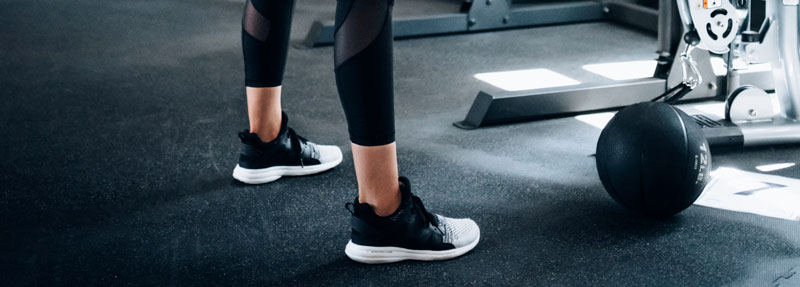
The trainer has long symbolised the drawbacks of globalised capitalism. Designed in Western countries, produced in Asia at low cost, with launches backed by big investments in marketing and advertising, it is sold at high prices, driving value up for the brand and its share price.
Result: of all the apparel that we wear, trainers have one of the biggest carbon footprints.
According to a study carried out by MIT (Massachusetts Institute of Technology), a standard pair of running shoe type trainers generates around 13.6 kilos of CO2 emissions. Most of these are down to the manufacturing process. Among others, because a trainer is mostly made of plastic and also polyester, thermoplastic polyurethane (TPU) or ethylene-vinyl acetate (EVA), all derived from petrochemical oil. And also because the whole production chain reproduces the vices of fast fashion (pollution, poor working conditions, etc.).
An epiphany
Even if we are aware of this negative impact, we keep buying these products, because their technical credentials guarantee comfort and stability (essential in a high-performance shoe), while in terms of looks they always reflect the latest fashion trend.
Fortunately there are changes coming into view on the horizon. A study carried out by the start-up Retviews, published in 2020, confirms that the pandemic has placed defending the environment and fighting wastefulness at the heart of considerations, especially among the generation Z cohort, the biggest trainer consumers. 90% of them are prepared to change the way they behave as consumers, to the point that big brands (and new ones) in this segment have already begun to make changes by reviewing their product development and manufacturing processes, with greater transparency and more sound ethics to satisfy these young consumers.
The alternative offering is broadening
Over the past ten years or so, new brands have been created all over the world claiming that their manufacturing processes are more virtuous, more ethically sound and more green.
Veja, the pioneer
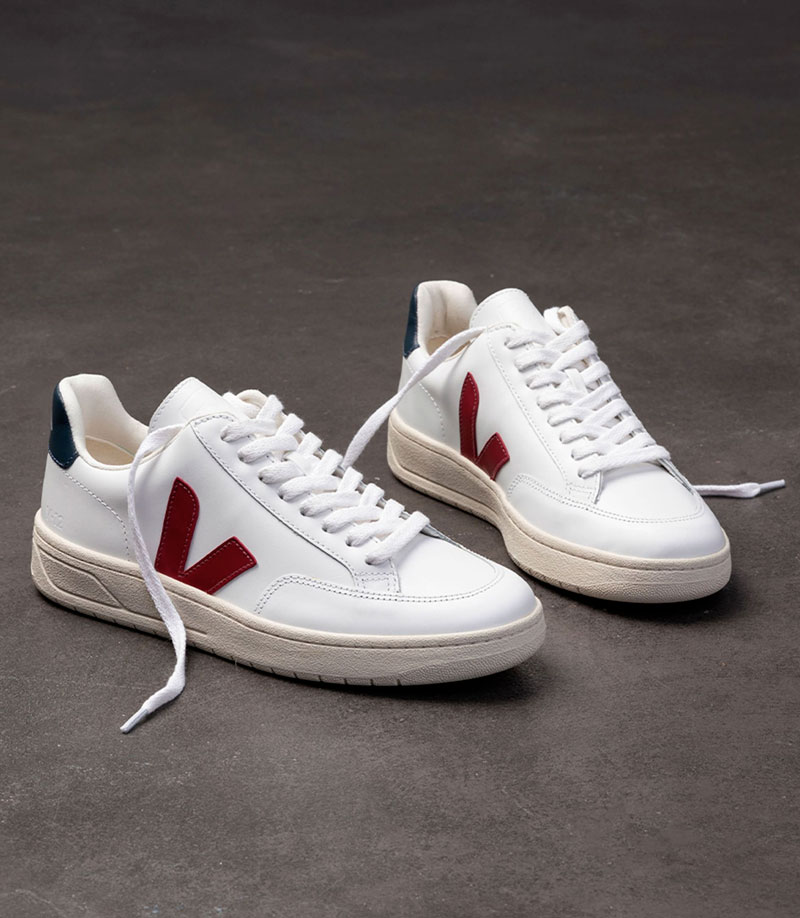
Since 2005, Franco-Brazilian brand Veja has offered fairtrade organic trainers made with materials that are more costly but more sustainable, and made by better-paid workers. So Veja set up its factory in Brazil in line with fairtrade principles, using as much sustainable raw material as possible: wild rubber, organic cotton or leather tanned with plant-based substances. As for distribution, Veja awarded its logistics contract to a company in Bonneuil-sur-Marne (France) that helps disadvantaged people back into employment. A discreet brand when it launched, and embraced by Marion Cotillard in the early 2010s, it was all over social media once sported by Meghan Markle and Emmanuel Macron. The Veja Condor created in late 2019 was “the world’s first post-petroleum running shoe”. Despite everything, the brand acknowledges on its website that it still comes up against the limits of 100% ethically-sound and organic shoe manufacturing (rivets and dyes, etc.). In Veja’s wake, a great many new brands have been created. For example, in the UK, Vivobarefoot, the minimalist footwear company, is aiming for full circularity with its Primus Lite II Bio model which is more than 30% made up of natural plant-based materials like maize, natural rubber and seaweed.
150 new brands in France
In France, 150 new brands have entered the trainer market over the past five years, putting the issues of environmental responsibility, ethics and/or ecological impact front and centre.
The 1083 label, which had already set itself apart with its responsibly-made jeans, created the 903 trainer which in 2020 became fully vegan. We can also mention Sessile (eco-designed, repairable and made in France), Caruus (a model made in France from recycled, upcycled linen) and Clae (made from cactus leather).
Wilo is launching a trainer that’s “zero plastic”, 100% plant-based, biodegradable and made in France. Ector trainers are crafted entirely out of recycled plastic bottles, between Saint-Etienne and Romans (France). Also worth noting are the ethically-sound initiatives with partnerships under development in some countries: Panafrica with Morocco, Burkina Faso and the Ivory Coast, or Perus which uses artisan workmanship in Peru as part of a fairtrade approach.
TBS (Eram group) recently unveiled the RE-Source, a model that’s endlessly recyclable. And the famous tennis shoe brand Bensimon has just put out its eco-designed version, dubbed the B-79. Comprising two models, the range made in Spain features outer soles made from recycled natural rubber and inner soles made from recycled cork, while the shoe uppers are made from organic cotton.
Recycled, upcycled, made from sustainable raw materials or recycled plastics, anything goes. And where they are not made in France, they are produced under ethically-sound conditions.
Big sporting goods brands follow suit
These emerging brands, the big campaigns of 1990-2000 and consumers’ wish to behave more responsibly as consumers have pushed big brands to review their practices. They have all introduced more eco-friendly approaches to manufacturing, and some (Nike and Adidas) have gone as far as taking a stand against the forced labour of Uyghurs, at the risk of being boycotted in China.
Here’s the backstory.
In 2018 Nike enlisted American footballer Colin Kaepernick, who had come to symbolise the political side of the Black Lives Matter movement, for the 30-year anniversary campaign of its “Just Do It” slogan. This was met with rage from white supremacists and Trumpites. But the fact remains that, according to the Clean Clothes Campaign – which promotes social progress against human rights breaches in the workplace – labour costs account for only $3 of a trainer’s $80 price tag!
New manufacturing technologies

© Nike 
© Le coq sportif 
© Adidas 
© Reebok 
© Yeezy
Leading brands now care deeply about reconciling technology and environmental responsibility:
- Nike Flyknit technology – which uses recycled polyester from plastic bottles to form high-precision knitted mesh – is said to generate 60% less waste than conventional manufacturing, and is said to have prevented the generation of 1.5 million kilos of waste. Nike has made the circular economy one of its main considerations. As well as its Space Hippie trainers made from recycled plastic to reduce the amount of waste it generates, the brand with the tick decided to put its little-worn pairs back on sale. It also puts shoes with slight manufacturing flaws on sale. Dubbed Nike Refurbished, this new service is already available in a few stores in the US and will soon be rolled out to a total of 15 Nike Store branches. In summer 2021 Nike is also planning to put out a vegan line called Better which, not least, is set to include Air Force models.
- As for Le Coq Sportif, it has unveiled two models that are 100% plant-based, made from grape must (residues that go unused after the extraction of juice for the production of wine or grappa). Produced in Portugal from materials sourced from Italy, the inner sole is made from cork, the outer sole from rubber and the laces are cotton. There are two models on offer: the Nérée, with a retro running shoe look, and the Gaïa, which is reminiscent of the brand’s Court models.
- Adidas, the brand with the three stripes, already introduced more eco-friendly production processes for its trainers back in 2015, with a model developed in conjunction with Parley For The Ocean, made from recycled plastic marine waste (15 million pairs sold in 2020). In early 2021 the German manufacturer launched the Stan Smith Primegreen, which is made up of 50% recycled materials, with a Primegreen upper, a recycled rubber sole and recycled polyester and rubber laces. Adidas has also announced the upcoming launch of the Stan Smith Mylo, made from mushroom leather. Since 2019 the brand has also launched the Futurecraft.loop, a high-performance running shoe made from polyurethane thermoplastic – a type of plastic that’s considered sustainable – and free from glue, 100% recycled and recyclable, which the brand hopes is endlessly recyclable.
- In late 2019 Reebok, which is part of the Adidas group, unveiled a pair of vegan running shoes. They are made from ricin seeds and natural rubber (the sole), seaweed foam (the lining) and eucalyptus wood (the shoe upper). This sportswear brand already had a pair of eco-friendly trainers in its assortment, made from organic cotton and maize (the sole).
- As for the streetwear label Yeezy managed by Kanye West, its Clog trainers are fully biodegradable, made from seaweed foam.
Progress made on the ethically-sound and eco-friendly fronts
Following the big campaigns of the 1990s, which lifted the lid on the insalubrious working conditions not least among Nike subcontractors in Indonesia, in 1992 the firm introduced a Labour Code, which was then revised in 1998 and 2001. This code prohibits forced labour and child labour, guarantees workers a minimum wage (or a going rate in the industry) and the right to gather and engage in collective bargaining in a safe, healthy working environment. Large American NGOs that work internationally, like the Fair Labor Association (FLA), perform actual checks, on the ground, on working conditions in the factories under scrutiny. But that fact remains that big sportswear brands produce on a mass scale in south-east Asia. In addition, over the past ten years or so, faced with rising labour costs, they have in large part been relocating their production to factories in Vietnam, Cambodia and Indonesia.
Since September 2019, Nike has also been implementing the Move to Zero program, aiming to reach zero carbon emissions and zero wastefulness. To get there, the company intends have all of its sites powered by renewable energy by 2025 and to cut its greenhouse gas emissions by 30%.
So some brands go down the fairtrade route, others down the recycled raw materials route, and others still opt for new raw materials that are upcycled and vegan. So which of these should you favour?
Is a brand environmentally responsible if it manufactures recycled goods, yet in factories with questionable working conditions?
Trainer manufacturing is still far from perfect, but again, the tide is turning. Another crucial point remains. In late March 2021, French M6 magazine programme Capital aired a report stating that 600 million pairs of shoes are thrown away each year in France. 90% of these are said to end up in landfill or get incinerated. While production is becoming more and more responsible, consumers are yet to do the same…


